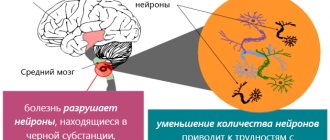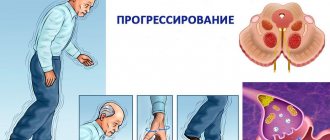Parkinsonism, or Parkinson's disease, is a degenerative disease of the central nervous system, which in most cases results in disability and death.
Parkinson's disease is defined by four characteristic features that make up the tetralogy of parkinsonism:
- shaking (tremor) of the head, limbs,
- muscle stiffness (stiffness),
- limited movement (hypokinesia),
- changes in gait, posture (postural disorders).
Parkinsonism is a common neurological disease, affecting 120–180 people out of 100 thousand, and the disease has a pronounced age dependence.
Our expert in this field:
Lashch Natalia Yurievna
Neurologist of the highest category, candidate of medical sciences, associate professor. Laureate of the Moscow City Prize in the field of medicine.
Call the doctor Reviews about the doctor
Causes
There are two types of Parkinson's disease. The first is true parkinsonism, it accounts for up to 80% of cases of the disease.
The second is parkinsonism syndrome, which accompanies traumatic brain injuries, encephalitis, stroke, and brain tumors.
The exact causes of true parkinsonism, or Parkinson's disease, are unknown.
But several facts have been established:
the disease develops mainly in old age (after 60 years),
degenerative changes begin with the irreversible process of death of neurons in the brain stem,
the development of symptoms of the disease is associated with a lack of dopamine, a neurotransmitter on which signal transmission in interneuron connections depends,
there is a genetic predisposition.
In approximately 15% of cases, Parkinson's disease occurs against the background of a negative family history (presence of the disease in close relatives) and is inherited.
Some factors may influence the development of the disease:
- intoxication (chronic poisoning with chemical toxins in hazardous industries, unfavorable environment, exposure to pesticides, manganese),
- infectious lesions of the central nervous system (encephalitis, etc.),
- traumatic brain injuries,
- impaired functioning of the kidneys and liver.
Disease prevention
Prevention of Parkinson's disease is relevant in case of hereditary predisposition. It is impossible to prevent the disease 100%, but you can reduce the likelihood of its development.
For this it is important:
- give up alcohol;
- not be overweight;
- adhere to an adequate drinking regime - at least 500 ml of water per day;
- physical activity – reduces the risk by half;
- use protective equipment when working with harmful substances;
- drink coffee regularly - 2 cups a day if there are no contraindications, this activates the brain and tones it.
Eating foods rich in antioxidants and vitamins helps slow down the development of cerebral atherosclerosis. Against the background of good blood flow, the disease is more difficult to appear. Products for the prevention of Parkinson's disease.
- spinach;
- beef;
- cottage cheese;
- carrot;
- eggs;
- green pea;
- nuts;
- bulb onions
Symptoms
The development of Parkinson's disease is directly related to a lack of dopamine - this is one of the neurotransmitters that ensure the transmission of signals in interneuron connections. That is, the conductivity of nerve fibers.
A lack of dopamine leads to the fact that signals in interneuron connections “freeze”, the speed of their transmission sharply decreases, this leads to impaired motor functions and mental abilities.
This is why Parkinson's disease is always accompanied by both motor and mental impairments.
The first signs of the disease are rarely a cause for concern - stiffness of movement in the right half of the body, twitching (trembling) of the hands, oily skin and hair, frequent depression, constipation.
Over time, pronounced tremor occurs - trembling of the arm, leg, and then the head, involuntary movements of the fingers.
At an early stage, the tremor affects only one arm (leg), and then spreads to the second. Tremors always begin in the limbs, and head tremor joins with the development of the disease.
The person’s movements become slow, the gait is shuffling. He moves in small steps, before turning around, marking time.
The back is bent in an arch, the head is lowered, the arms and legs are bent, and a characteristic stoop is formed - the “petitioner pose.”
Facial expressions are becoming increasingly impoverished. The face becomes motionless and loses expression. The impression arises that the person does not react to anything.
The muscles become less and less mobile, rigid, it becomes difficult for a person to make movements, their volume is increasingly limited. He cannot fasten buttons, tie shoelaces, shave, brush his teeth, and over time he completely loses the ability to take care of himself in everyday life.
Speech changes - it becomes unintelligible, quiet, monotonous.
Over time, the clinical picture is supplemented with new symptoms:
- dementia develops
- impotence occurs,
- urination increases,
- swallowing is impaired,
- the skin becomes dry,
- sweating increases,
- sense of smell worsens,
- sleep is disturbed
- blood pressure decreases,
- salivation increases.
Forms of the disease
The forms of Parkinson's disease are determined depending on which of the symptoms is most severe.
1. Trembling form - trembling (tremor) predominates in the arm, leg or both arms, legs, head, and the most pronounced tremor is at rest. With movement, it may weaken or even disappear.
2. Rigid form – characterized by stiffness in the muscles, especially when starting to move, and limited mobility.
3. Akinetic form - characterized by slowness of movements, impoverishment or complete absence of facial expressions.
Along with these three main forms, mixed forms are distinguished: rigid-tremorous, tremulous-rigid, akinetic-rigid, etc.
Hoehn-Yahr classification of Parkinson's disease
Neurologists use the Hoehn-Yahr classification of Parkinson's disease. There are five degrees of severity:
- the first stage is characterized by the presence of unilateral symptoms of Parkinsonism (hemiparkinsonism);
- in the second stage, signs of the disease spread to the other side, there is no postural instability;
- in the third stage, moderate postural instability occurs;
- the fourth stage is characterized by a significant limitation of motor activity, but patients retain the ability to move independently;
- at the fifth stage of the disease, the patient is confined to a wheelchair or bed.
How long do patients with Parkinson's disease live? The prognosis is less favorable for the akinetic-rigid form, since it usually progresses more quickly and is characterized by more varied and more severe non-motor symptoms. Patients develop postural instability and dementia early and become disabled much earlier. A relatively favorable course of Parkinson's disease is characteristic of the trembling form and with the left-sided onset of the disease.
At advanced stages of the disease, the development of motor functioning is characteristic, i.e. motor fluctuations, as well as non-motor symptoms during the day associated with long-term use of levodopa. In the simplest form, fluctuations are manifested by the dependence of the state on each dose of levodopa taken; later this connection is lost, unpredictable involuntary movements of the limbs and painful dystonic spasms of the limbs appear.
Stages
There are five main stages in the development of Parkinson's disease.
At stage 1, trembling appears in only one arm or leg. Usually the disease manifests itself as trembling of the fingers of the right hand.
At stage 2, trembling (tremor) spreads to the second arm (leg). Sleep is disturbed, appetite worsens, excessive salivation occurs, and the chin begins to twitch.
At stage 3, balance is disturbed, body posture changes, the gait becomes shuffling and slow, but the person can still perform ordinary everyday movements and take care of himself. The tremor becomes more and more intensified, speech is impaired, the face becomes emotionless.
At stage 4, changes in gait and body posture become more pronounced. While walking, a person may fall. He can still walk, but can no longer perform simple actions or take care of himself (fasten buttons, hold a spoon). Depression develops.
At stage 5, a person loses the ability to move (walk, stand, sit), coordination of movements is lost. Speech becomes illegible, slurred, swallowing and urination are impaired. Without outside help, his life becomes impossible.
The progression of the disease can be slow, moderate or rapid. In the first case, the transition from one stage to another occurs within five years or longer, in the second case - within 3 - 5 years, in the third case - within two years.
Symptoms and signs in women
At the initial stage of the disease, the first signs of parkinsonism appear:
- loss of strength : chronic malaise and sleep disturbance are observed;
- changes in gait: steps become slower, shorter, a feeling of instability arises, so the person staggers a little when walking;
- slurred speech: the patient periodically loses his thoughts, forgets the essence of the dialogue;
- handwriting changes: the letters look very small and may differ in size and style;
- unemotional: the patient’s face looks absolutely unemotional, facial expressions are almost completely absent;
- depression: long-term, causeless depression appears, mood changes sharply;
- muscle rigidity: muscles are unnaturally tense;
- tremor: spontaneous shaking of the lower and upper extremities.
Early diagnosis of the disease will help the patient significantly maintain quality of life. As the disease progresses, symptoms also develop.
The main symptoms of the disease appear:
- increased rigidity: motor muscles are under severe tension, it is difficult for a person to carry out any movements;
- mask: the face has the expression of a mask;
- arms/legs are constantly bent: when trying to return the limb to a normal position, the movements look intermittent, jerky - a symptom of a gear wheel;
- tremor: the hands are constantly shaking (visually reminiscent of counting coins with your fingers or rolling a ball), in addition, there is trembling of the chin and feet, these symptoms recede only during sleep;
- bardykinesia: excessive slowing down of actions (daily procedures - brushing teeth, dressing, washing - take several hours);
- muscle spasms: muscle spasms throughout the body;
- acute coordination disorder: falls more often when standing up, walking;
- disorders of defecation: (constipation) and urination (urinary incontinence);
- depression: severe depressive state - a person becomes fearful, unsure of himself, afraid of crowded places;
- speech: poorly recognized, the voice becomes nasal, the same words are often repeated when speaking;
- fragmented memory loss;
- rest disorder: the presence of nightmares, muscle numbness prevents a person from sleeping peacefully;
- sweating increases;
- salivation;
- Dementia: impairment of intellectual abilities (slow thinking, inattention, personality changes);
- dry skin: dandruff on the head.
Diagnostics
At the initial appointment, the doctor at the Medica24 International Clinic asks the patient (or his relatives) about the symptoms, the time of their appearance, the dynamics of development, as well as the presence of diseases in the family. This is called taking a personal and family history.
After this, the doctor conducts an external examination, paying attention to violations of coordination, movements, body posture, and uses several tests to assess the degree of rigidity, akinesia (for example, a test for clenching and unclenching a fist, etc.).
When diagnosing, the doctor must differentiate Parkinson's disease from many neurological disorders by the presence of strokes, antipsychotic therapy, the presence of long-term remissions (Parkinson's disease develops without remissions), traumatic brain injuries, a history of encephalitis and a number of other signs.
After establishing a preliminary diagnosis, if Parkinson's disease is suspected, the doctor will refer the patient for additional examinations.
1. Rheoencephalography.
This is a research method using a weak high-frequency electric current that shows the nature of blood circulation in the brain.
2. Electroencephalography.
EEG helps to assess the general and local functional activity of the brain and identify pathological foci.
3. Computed tomography.
A CT scan of the brain gives a detailed picture of blood circulation, the condition of the nervous tissues of the brain, and helps to detect pathological areas and tumors.
4. Magnetic resonance imaging.
MRI of the brain is performed using a magnetic field and, unlike CT, does not expose the brain to radiation. Therefore, this type of examination can be carried out many times. MRI helps to examine in detail the state of the nerve tissue of the brain and detect areas of neuronal damage.
Along with these basic diagnostic methods, laboratory tests are used, and, if necessary, other high-tech, modern examinations, which allow her not only to clarify the diagnosis, but also to determine the best treatment tactics.
Methods
A population-based study was performed using data from the Rochester Epidemiology Project (Minnesota) on patients diagnosed with parkinsonism from 1991 to 2010.
Each medical history was assessed by a specialist neurologist to confirm parkinsonism and determine the type of synucleinopathy.
Each patient with a confirmed diagnosis was matched by age and gender with individuals from the general population.
The primary endpoints chosen for the study were mortality for each type of synucleinopathy, time between diagnosis and death, and cause of death.
Treatment
The main drug treatment for Parkinson's disease is levodopa.
This is a symptomatic remedy that replenishes the lack of dopamine and thus eliminates the main cause of the symptoms of the disease - hypokinesia, tremor, rigidity.
To stimulate the synthesis of dopamine in the brain and increase its level in interneuron synapses, selective MAO-B inhibitors (selegiline), amantadine, piribedil, and pramipexole are used.
In complex therapy of the disease the following are also used:
- antipsychotics (to reduce mental symptoms),
- antispasmodics,
- antidepressants, tranquilizers (to eliminate insomnia, pain),
- akatinol, vinpocetine and other drugs to improve memory and speech.
Treatment of Parkinson's disease in the later stages is complicated by the fact that the effect of levodopa is reduced and side effects increase.
All this requires constant medical supervision and timely adjustment of drug therapy, prescription of additional drugs, and dosage changes.
At the last stage of the disease, the patient needs professional medical care, which can be fully provided only in a hospital setting.
Medical care and symptomatic therapy at the Medica24 International Clinic help improve the quality of life and increase its duration, and slow down the development of Parkinson’s disease at a late stage.
We will call you back
Message sent!
expect a call, we will contact you shortly
Forecast
If left untreated, Parkinson's disease has a negative prognosis. During the first 5 years, 25% of patients experience disability and/or death, and within 7–10 years this figure exceeds 50%.
This is why early diagnosis and treatment of Parkinson's disease is so important. But even at a late stage of the disease, modern methods used in the international clinic Medica24 help to significantly improve a person’s condition.
The material was prepared by Natalya Yuryevna, a neurologist at the International Clinic Medica24, Candidate of Medical Sciences Lasch.









